Recent Articles
Popular Makes
Body Types
2017 Nissan Titan Road Test and Review
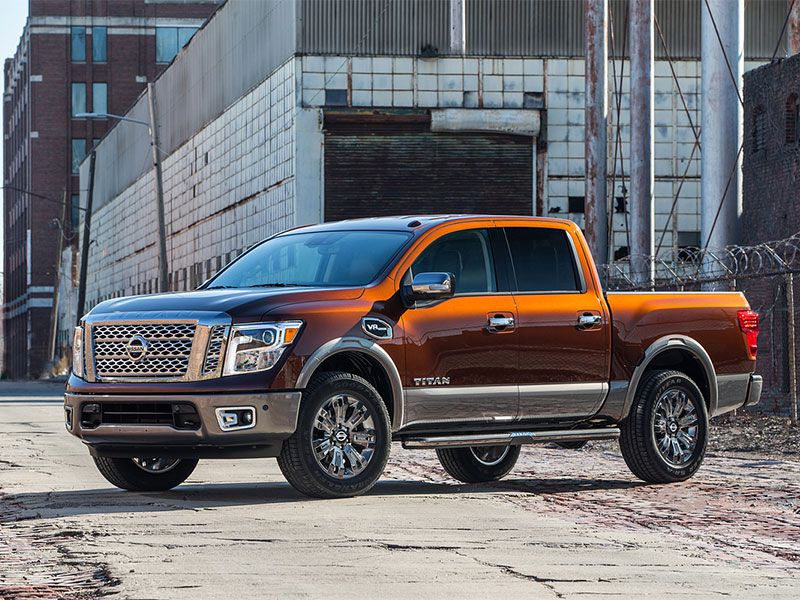
2017 Nissan TITAN Crew Cab exterior front angle ・ Photo by Nissan
For a Japanese automaker to break into the fullsize pickup market is tough—as tough as climbing Mt. Everest, or pitching a no-hitter, or getting Donald Trump to stop tweeting. And no one would know better than Nissan, which has struggled with sales of its full-size Titan pickup. But Nissan is making one heck of an effort with the all-new 2017 Titan. Last year the company introduced the Titan XD, an almost-heavy-duty model, and now we have the “half-ton” Titan, the truck that will do battle with the Ford F-150, Chevrolet Silverado 1500, Ram 1500, and Toyota Tundra. How does the new 2017 Nissan Titan stack up? Let’s put on our work gloves, hitch up the trailer, and find out.
Funny, you don't look like a half-ton.
From the outside, the new “half-ton” Titan (we use quotes because today’s 150/1500-class pickups haul way more than half a ton, but the nomenclature has stuck) looks a lot like the brawnier Titan XD. The cabs are identical and front-end sheetmetal nearly so (the XD has a slightly longer schnozz to accommodate the optional Cummins diesel). This is a departure from the domestics who often make their heavier-duty trucks look, er, more heavy-duty-ish. The half-ton Titan’s wheelbase is about a foot shorter than the XD’s, and overall the truck is nearly 15 inches shorter. The length comes out of the bed, which is 5.5 feet long on crew-cab trucks and 8 feet on single-cab trucks.
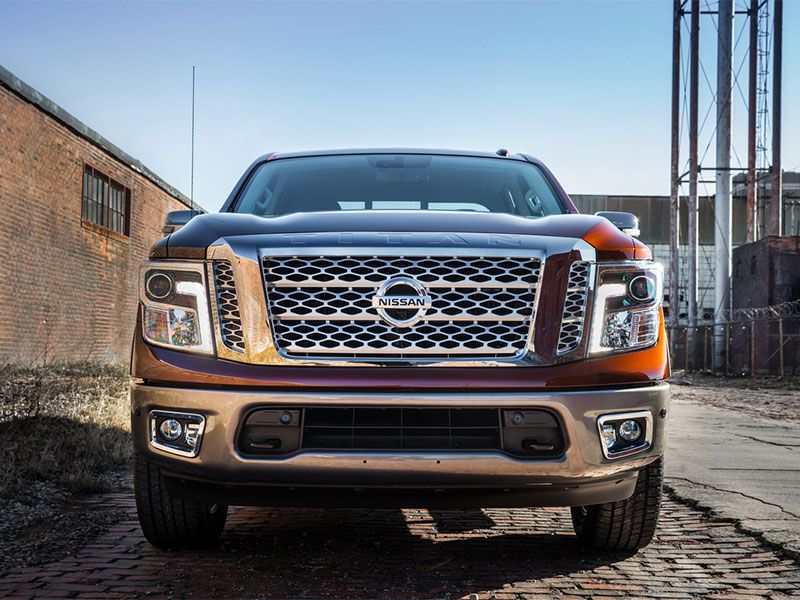
Photo by Nissan
The Blue-Collar Titan
With the Titan, Nissan isn’t just going for the high end of the market—it also wants to break into the work-truck arena. So, along with the generously equipped Platinum Reserve model, Nissan also makes a bare-bones single-cab Titan S. Most automakers keep these “stripper” vehicles as far from the motoring press as possible, but not Nissan—the company sent us two trucks to review, a Platinum 4x4 and a basic S model in refrigerator-white paint. While we were eager to sample the creature comforts in the Platinum, we also wanted to see how Nissan treats its industrial customers.
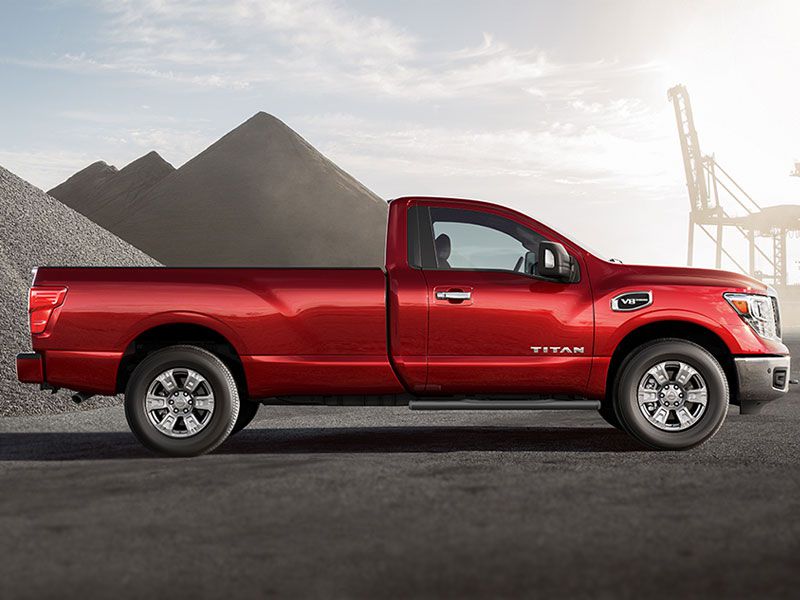
Photo by Nissan
Basic is Beautiful
There’s no question that the 2017 Nissan Titan S is the entry-level truck. On the outside, nearly all of the chrome that adorns the SV, SL, and Platinum Reserve is gone; the truck sports a plain black plastic grille, plain black plastic mirrors, and plain black plastic door handles. Even the chrome “Endurance V8” fender badge is gone. Our test truck, which had a single-row cab and a big 8-foot bed, looked particularly stark, which isn’t necessarily a bad thing—if we stenciled “Autobytel Air Conditioning and Heating” on the door, it would look right at home. We were surprised that the truck had no bed liner—it’s hard to remember the last time we saw a new pickup with an unlined bed—but the one option offered on the S is a Convenience and Utility package that bundles a spray-in bed liner and a hitch receiver for a reasonable $800.
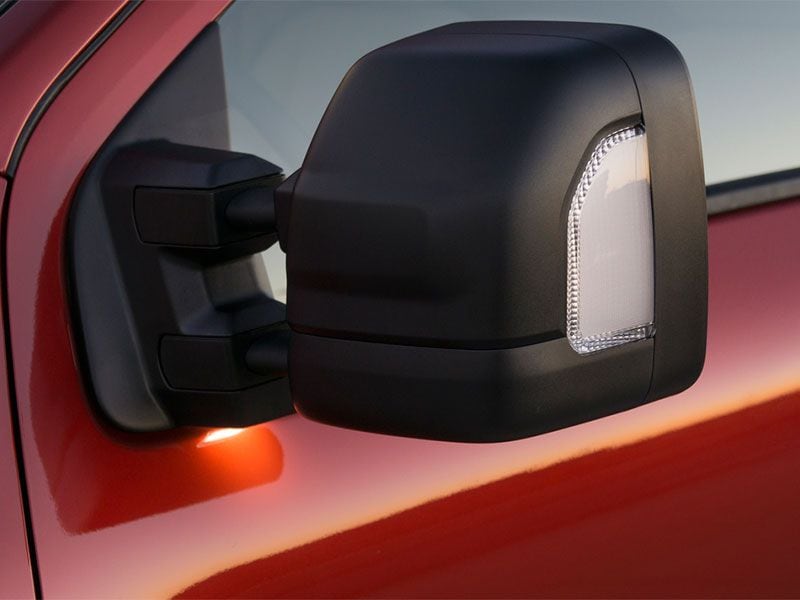
Photo by Nissan
Interior: Made for Work
Inside, the Titan S looks the part: You can get the cabin in any color you like provided it’s black, and the brightwork found on the doors, vent surrounds, door handles, and center stack on higher-trim Titans has been eliminated. Even the gauges are a bit more stark. And yet, for all of its plainness, we like the interior: The materials and switchgear are of excellent quality, and the controls are sensibly arranged and well labeled. Nissan has thoughtfully put thick vinyl on the outer edges of the cloth seats to reduce wear in commercial situations where drivers are constantly getting in and out. The floor is covered in vinyl rather than carpet, but road-noise insulation is just as good as it is in the carpeted truck. Though the manually-adjustable mirrors are a throwback, we like the power windows and locks, plus the keyless pushbutton ignition. The Titan S looks like an inexpensive truck, but it doesn't feel like an inexpensive truck. Our one complaint: The manually adjustable seat is mounted rather low in the cab.
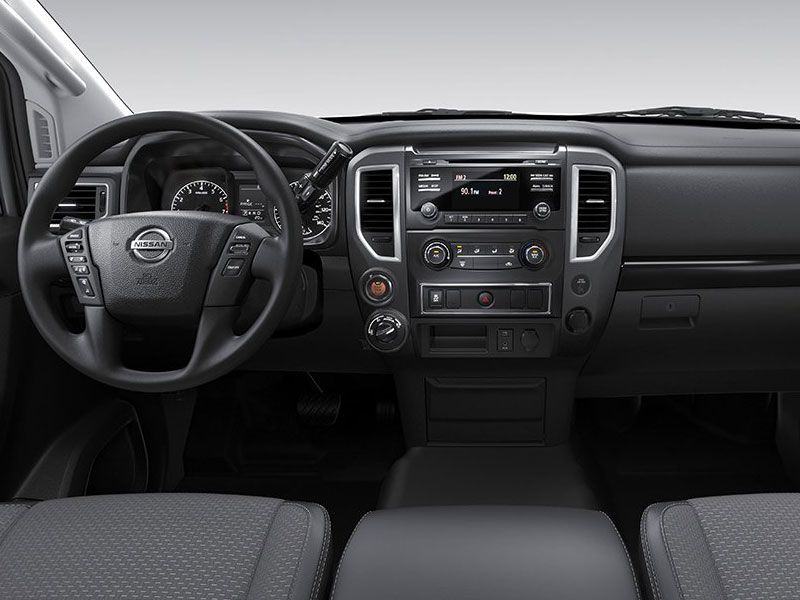
Photo by Nissan
Stepping Up to the Platinum Reserve
Our other Titan test truck, the top-of-the-line Platinum Reserve model, represents a stark contrast to the S with its handsome dark-chrome wheels and two-tone black-and-brown leather interior. The 4-door crew cab provides generous back seat space, and the seat lifts up to provide extra storage. We loaded a heavy metal floor jack and jackstands back there, and were pleased (and somewhat relieved) to see that the tough plastics resisted scratching and marring. (Nissan has a flip-forward section that provides a flat, carpeted floor, but we didn’t want to take any chances.)
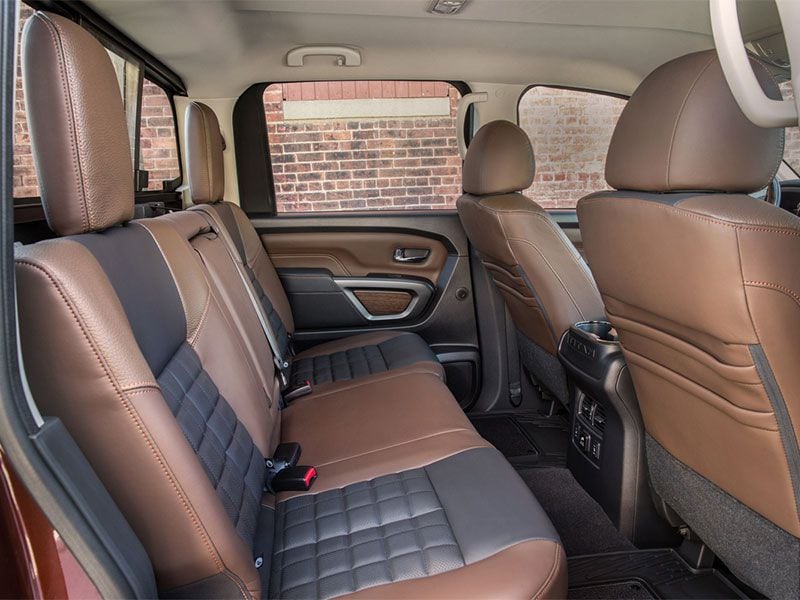
Photo by Nissan
Great Muscle, Lousy Fuel Economy
Both Titans had the same powerplant: Nissan’s 5.6-liter Endurance V8 (which, as it happens, is also shared with the Titan XD). This brawny 32-valve engine produces a strong 390 horsepower and 394 lb.-ft. of torque, and does so with an enthusiastic roar. All Titans come with a 7-speed automatic transmission, and both of our test trucks had 4-wheel-drive with a low-range transfer case (useful for off-roading) and a rotary electric shift knob. But unlike in some other pickups, Nissan doesn’t offer a full-time 4WD mode; this is a part-time system to be engaged only when the going gets rough, though it can be shifted from 2WD to 4-High while the Titan is moving. EPA fuel economy estimates are 15 mpg city/21 mpg highway for both 2WD and 4WD models, but we didn’t do anywhere near that well: The Titan work truck averaged in the mid-teens, while the Platinum—which we used for towing—stayed in the low teens. Nissan plans to add a V6 engine option later in the model run; let’s hope it gets better gas mileage.
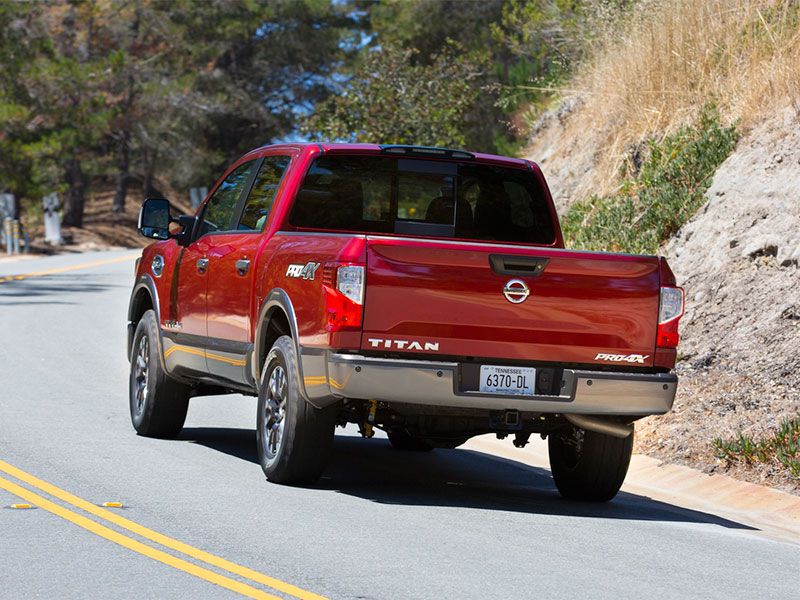
Photo by Nissan
Driving the Titan
Nissan assures us that if we were to crawl underneath a Titan and a Titan XD, we'd see significant differences in the chassis and suspension setups. While we declined to crawl underneath (we didn’t have an XD anyway), we did notice the difference in the ride; running unladen, the half-ton Titan does feel smoother, though ride quality doesn’t match up to our class favorite, the Ram 1500 with its optional air springs. (It’s a funny thing: Foreign truck manufacturers seem to make their pickups feel more burly and trucklike, while the domestics try to make them smoother and more carlike.) The Titan S, with smaller wheels and taller tires, rode a bit more softly. Handling is about what you’d expect from a pickup truck; the steering is nicely weighted, but you feel the Titan’s size and heft.
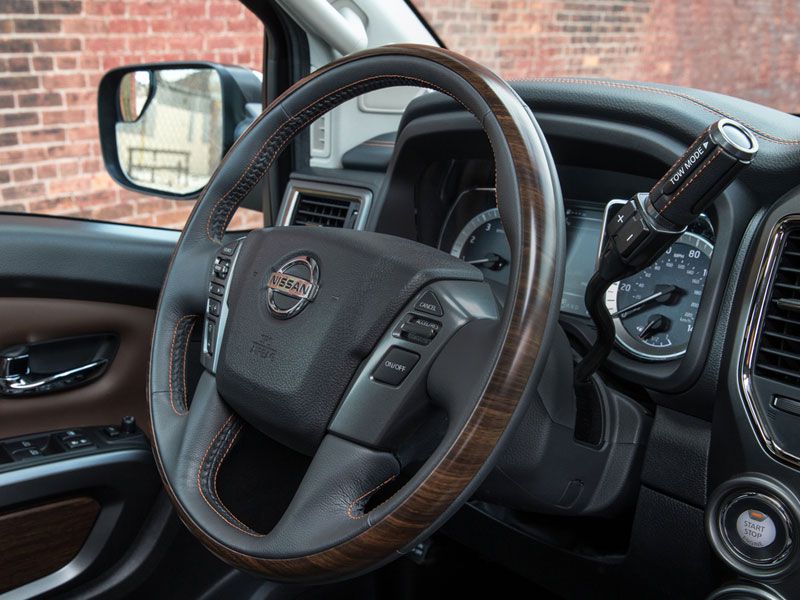
Photo by Nissan
How much work can it do?
The half-ton Titan has a maximum payload of 1610 lb. for 4x2 trucks and 1590 lb. for 4x4s; compare that to 2594 lb./2523 lb. for the gas-powered Titan XD (diesels haul about 500 lb. less due to the extra weight of the engine). But those numbers aren’t very good when compared to the RAM 1500 (up to 1890 lb.), Toyota Tundra (up to 2080 lb.), Chevy Silverado 1500 (up to 2250 lb.), and Ford F-150 (up to 3270 lb!). (Keep in mind that some other configurations undoubtedly will haul less—often significantly less. In these early days, Nissan has only published maximum payload ratings for the 2017 Titan.) The half-ton Titan is rated to tow up to 9390 lb., compared to 12,314 lb. for the diesel-powered Titan XD (again, these are maximum numbers and depend on proper equipment). And again the Titan is largely outmatched by the Toyota Tundra (up to 10,500 lb.), Ram 1500 (up to 10,640 lb.), Chevy Silverado 1500 (up to 12,500 lb.) and Ford F-150 (up to 12,200 lb.).

Photo by Nissan
Towing with the Titan
We put the Titan’s towing abilities to the test by hooking up our horse trailer to the crew-cab Platinum 4x4 (the Titan S did not have a trailer hitch). Nissan makes connecting the trailer relatively easy; the backup camera has a wide-angle view, which makes it simple to get the hitch ball under the trailer, though the thick guidance lines sometimes get in the way. The Titan comes with both 4- and 7-pin wiring hook-ups, another nice feature (there’s nothing like delaying your vacation while you run to the auto parts store for an adapter you didn’t realize you needed, and yes, we speak from experience). We love the trailer light test feature: Pressing the right sequence of buttons on the remote cycles through the turn signals, brake lights, and running lights, so you can perform this crucial test without an assistant.
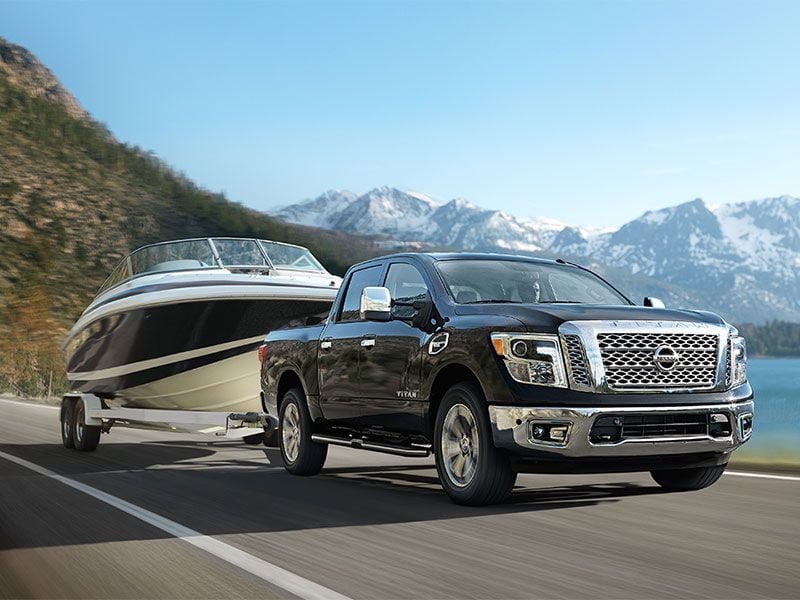
Photo by Nissan
How well does it tow?
With one horse aboard, our total trailer load was at about 5000 lb., well within the Titan’s capabilities. Towing was a very pleasant experience: The Titan feels very stable, and despite strong winds and a somewhat impatient horse (who likes to remind us of his presence by dancing a little jig in the trailer), the rear end of the truck felt well planted, though there was a bit more motion that we noticed when towing the same setup with a Titan XD. The V8 had plenty of power to maintain speed up California's steep Santa Susana Pass, and the built-in trailer brake controller worked well. Our only complaint, again, gas mileage: The Titan averaged just under 9 mpg while towing. Under similar conditions, a Ford F-150 we tested last year averaged 12 mpg.
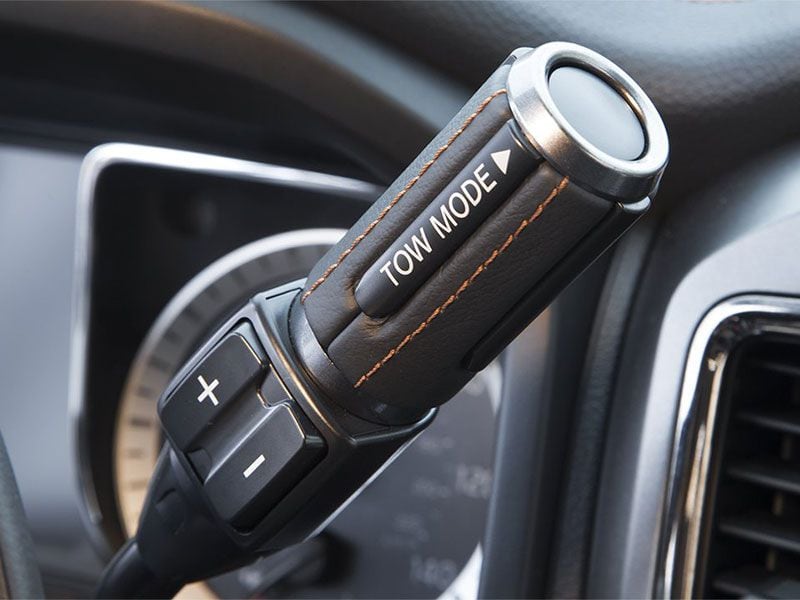
Photo by Nissan